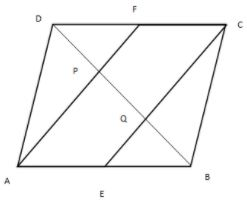
In a parallelogram ABCD, E and F are the mid-points of sides AB and CD respectively (according to the figure). Show that the line segments AF and EC trisect the diagonal BD.


Answer
568.2k+ views
Hint: In order to show that the line segments AF and EC trisect the diagonal BD we use the Midpoint theorem and general properties of parallelogram.
Midpoint theorem states that the midpoint of a side in a parallelogram bisects it in two halves. Opposite sides of a parallelogram are parallel and equal in length.
Complete step-by-step answer:
Given that ABCD is a parallelogram.
Using the property of parallelogram, we say
AB || DC and AB = DC.
E is the midpoint of AB
${\text{AE = }}\dfrac{1}{2}{\text{AB - - - - - }}\left( 1 \right)$
Also F is the midpoint of CD
Therefore ${\text{CF = }}\dfrac{1}{2}{\text{CD}}$
${\text{CF = }}\dfrac{1}{2}{\text{AB }}\left( {\because {\text{CD = AB}}} \right){\text{ - - - - }}\left( 2 \right)$
From equation (1) and (2), we get
AE = CF
Also,
AE || CF (∵AB || DC)
Thus a pair of opposite sides of a quadrilateral AECF are parallel and equal.
Hence quadrilateral AECF is a parallelogram.
So, now we have
EC || AF
EQ || AP and QC || PF
In ∆BPA, E is the midpoint of BA and EQ || AP
Using mid-point theorem, we have
BQ || PQ ---- (3)
Similarly by taking ∆CQD, we can prove that
DP = QP ---- (4)
From (3) and (4), we get
BQ = QP = PD
Therefore, AF and CE trisect the diagonal BD.
Note: In order to solve this type of problems the key is to always remember that symmetry allows to reduce a theorem to a computation. Never try to solve a problem with a figure by solving directly without proof. In case of trisection, we have proved that all the three parts of the line are equal.
Midpoint theorem states that the midpoint of a side in a parallelogram bisects it in two halves. Opposite sides of a parallelogram are parallel and equal in length.
Complete step-by-step answer:
Given that ABCD is a parallelogram.
Using the property of parallelogram, we say
AB || DC and AB = DC.
E is the midpoint of AB
${\text{AE = }}\dfrac{1}{2}{\text{AB - - - - - }}\left( 1 \right)$
Also F is the midpoint of CD
Therefore ${\text{CF = }}\dfrac{1}{2}{\text{CD}}$
${\text{CF = }}\dfrac{1}{2}{\text{AB }}\left( {\because {\text{CD = AB}}} \right){\text{ - - - - }}\left( 2 \right)$
From equation (1) and (2), we get
AE = CF
Also,
AE || CF (∵AB || DC)
Thus a pair of opposite sides of a quadrilateral AECF are parallel and equal.
Hence quadrilateral AECF is a parallelogram.
So, now we have
EC || AF
EQ || AP and QC || PF
In ∆BPA, E is the midpoint of BA and EQ || AP
Using mid-point theorem, we have
BQ || PQ ---- (3)
Similarly by taking ∆CQD, we can prove that
DP = QP ---- (4)
From (3) and (4), we get
BQ = QP = PD
Therefore, AF and CE trisect the diagonal BD.
Note: In order to solve this type of problems the key is to always remember that symmetry allows to reduce a theorem to a computation. Never try to solve a problem with a figure by solving directly without proof. In case of trisection, we have proved that all the three parts of the line are equal.
Recently Updated Pages
Master Class 12 Economics: Engaging Questions & Answers for Success

Master Class 12 Maths: Engaging Questions & Answers for Success

Master Class 12 Biology: Engaging Questions & Answers for Success

Master Class 12 Physics: Engaging Questions & Answers for Success

Master Class 8 Maths: Engaging Questions & Answers for Success

Class 8 Question and Answer - Your Ultimate Solutions Guide

Trending doubts
Why is there a time difference of about 5 hours between class 10 social science CBSE

Write a letter to the principal requesting him to grant class 10 english CBSE

What is the median of the first 10 natural numbers class 10 maths CBSE

The Equation xxx + 2 is Satisfied when x is Equal to Class 10 Maths

Which of the following does not have a fundamental class 10 physics CBSE

State and prove converse of BPT Basic Proportionality class 10 maths CBSE




